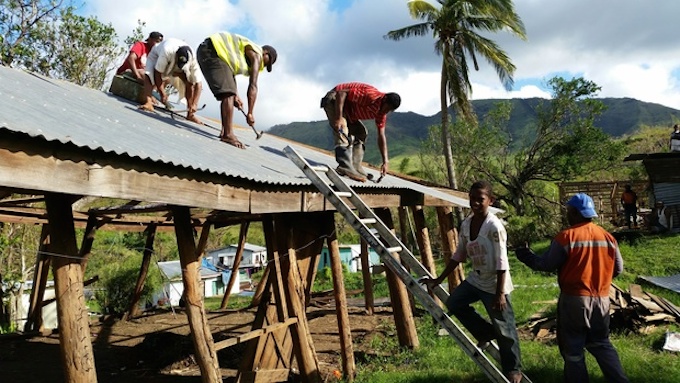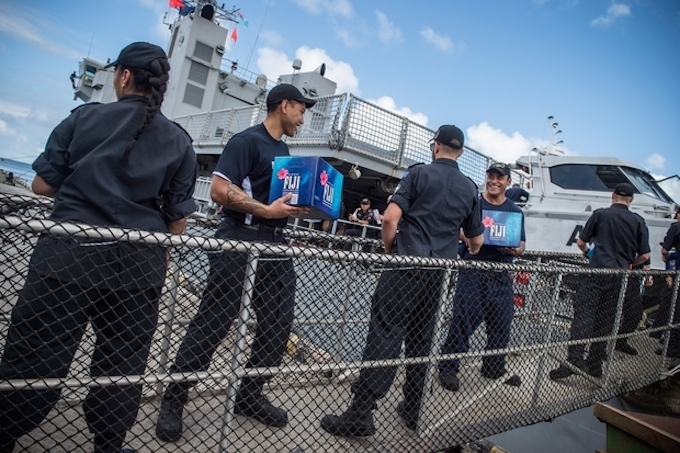Day 9 – Alex Perrottet reporting via Skype on Monday from Vanua Balavu for RNZ’s Checkpoint
By Alex Perrottet of Radio New Zealand International
Around half of Fiji’s houses will have to be rebuilt after the devastation caused by Cyclone Winston, damage assessors say.
In the worst-hit areas, villages have been destroyed, and tens of thousands of people are still in evacuation centres as they wait for long term shelters to be set up.
Teams of builders and engineers say they will submit reports saying many ruined houses were simply not built to standard.
In the Lau Group, just off the coast of Vanua Balavu, the Fiji government ship MV Cagivou carried aid and damage assessment teams representing almost every ministry, from energy to education.
A supply boat from New Zealand’s multi-role HMNZS Wellington also arrived with a load of 10-litre water containers.
Lieutenant Leroy Judge, the man in charge of the initial deployment, said the Wellington had a desalination plant “so it can keep producing as much water really as required until it essentially runs out of diesel.”
The day before it had produced about 3000 litres and that day it gave some 2000 litres to the closer islands.
The Cagivou was running late. Crew members started to fill containers from the ship’s own water tank but the browner shade was a sign it would need to be boiled, and the message was sent out to the island.

Destroyed homes
Lomaloma school had become the military post. Out front, the almost compulsory game of one-touch football was underway.
But next door, in Lomaloma village, no one was playing football. People were cutting up dead trees and burning them along with ruined possessions.
Titoka Nakavulevu, the turanga ni koro (chief), explained that 52 of the village’s 60 houses had been destroyed.
Hundreds of tents were at the command post, and Titoka Nakavulevu was grateful they had arrived – but they had not quite been dispatched to the villagers yet.
Jesse Delailomaloma has set up a tiny tarpaulin on a small slab so his wife and grandson can sleep above the ground. Next to it is a pile of wood and tin that used to be their house.
He was waiting for the tent supplies and was not sure when they would get them. However, the first thing he needed was his house.
“Never mind the food or what, just the house to cover me from the sun and the rain.”

‘Six months to two years’ in tents
Commander Humphrey Tawake is in charge of the mission and said there was a reason for the delay.
“That was supposed to be done yesterday but we had a bit of difficulties,” he said.
“All the vehicles here are privately owned, so you have to have some sort of understanding.
“They pay for their own fuel and we have to make some sort of arrangements that is a balanced approach so that they get their money’s worth and the assistance is given. Having said that, those will be gone by this morning.”
But the commander said they would not be enough. He needed more than 800, immediately, and they had to be good enough to house people until their homes were rebuilt.
“The tarpaulins are not good enough, because the houses I’ve seen here, we need tents that will accommodate from six [months] to two years. People can live in them, because some of the reconstruction material and some of the tarpaulins won’t last.”
Building techniques exposed
Savenaca Volau is an elderly man who crawled with his wife under the floorboards after half his house was ripped away by the storm and the furniture was blown out.
He argued Fijians would be better off building their traditional bures, made from coconut palms and bamboo, as most people died from corrugated iron and glass cuts or crushing concrete.
“The young people now, they don’t know how to do that kind of Fijian roof. Only the people, those old people, but we people. I can make it, I can make the thatch.”
Mr Volau agreed it was important to teach the next generation how to build the thatches.
“But this people here, the new generation, they don’t like the old one, I don’t know why.”
Engineers on board the Cagivou said they had seen multiple building errors in the ruined houses. Incorrect strapping methods and cost-cutting short cuts in the foundations were evident on the islands, far away from from the scope of government regulators.
The chief, Titoka Nakavulevu, saw the whole experience as having served as a lesson.
“It really teach us to safe, to build a proper house preparing for the hurricane, for the long term, for our families.”
Titoka said he would take his lead from the government, and the engineers agreed. They said the government needed to put out rebuild tenders to private companies who could bear the burden of compliance.

Unprecedented cyclone
But everyone agreed with Commander Tawake that this cyclone was unprecedented.
“You have storm surge, you had the cyclone and the wind, then you have … tornadoes.”
“Prior to that, for a couple of days we were having tremors, earthquake tremors, and it was like they were swimming in a swimming pool with tornadoes flying, roofing irons flying everywhere.”
He felt that with that combination the traditional bure would not survive.
“And the one thing that we must be, that we are, thankful of is that those who lost their lives [were not as many] as we would have expected with the level of devastation that is here.”
Commander Tawake said whatever the building style, it had to meet standards and be kept small. Bigger houses with greater surface area were more vulnerable to strong winds.
He said that at least 50 percent of Fiji had to be rebuilt, house by house, and that was going to take some time to finish.
Alex Perrottet, a reporter of Radio NZ International, has spent the past two weeks in Fiji reporting on the aftermath of TC Winston, often venturing to the most devastated remote parts of the country. He is a former Pacific Media Watch contributing editor at the AUT Pacific Media Centre and a Masters in Communication Studies graduate.









































